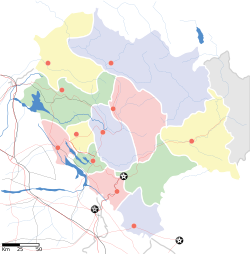Joginder Nagar
|
Jogindernagar जोगिन्दर नगर The City of Powerhouses |
|
|---|---|
| Hill Station | |

Town of Joginder Nagar and its sub-urban areas as seen from Siqandar Dhar
|
|
| Location in Himachal Pradesh, India | |
| Coordinates: 31°59′19″N 76°47′30″E / 31.988723°N 76.79155°ECoordinates: 31°59′19″N 76°47′30″E / 31.988723°N 76.79155°E | |
| Country |
|
| State | Himachal Pradesh |
| District | Mandi |
| Formation | 1925 |
| Founded by | Joginder Sen |
| Named for | King of Mandi |
| Government | |
| • Body | Municipal Council and Subdivision |
| Area | |
| • Total | 350 km2 (140 sq mi) |
| Elevation | 1,220 m (4,000 ft) |
| Population (2011) | |
| • Total | 110,302 |
| • Density | 320/km2 (820/sq mi) |
| Languages | |
| • Official | Hindi, English, Mandyali, Kangri |
| Time zone | IST (UTC+5:30) |
| PIN | 175015 |
| Telephone code | 1908 |
| Vehicle registration | HP 29 |
| Literacy | 87.86% |
| Climate | Humid subtropical (Köppen) |
| Avg. annual temperature | 19.6 °C (67.3 °F) |
| Avg. summer temperature | 27.5 °C (81.5 °F) |
| Avg. winter temperature | 10.1 °C (50.2 °F) |
Joginder Nagar or Jogindar Nagar ([dʒoːˈɡɪnd̪ər nəˈɡər]) is a municipal council and an administrative subdivision in Mandi district in the Indian state of Himachal Pradesh. Named after Raja Joginder Sen, the hill station is terminal point of 163 km long Kangra Valley Narrow gauge railhead. Joginder Nagar is the only town in Asia to have three hydro-electric power stations, and hence nicknamed The City of Powerhouses.
Located at the middle of Joginder Nagar Valley, the region is known for adventure sports of Paragliding and Trekking and packs options for sightseeing, mountain biking and camping. Popularly, the valley is known for three T's viz. Trolley, Trout and Train. In 2015, Joginder Nagar was declared the first free Wi-Fi city of Himachal Pradesh.
Jogindernagar has been named after the king of Mandi, Raja Joginder Sen. The name of the original village was Sukrahatti.
In 1925, Raja Joginder Sen and Col. B. C. Batty planned a hydel power scheme near the village of Sukrahatti. A narrow-gauge railway track was laid from Pathankot to Joginder Nagar (1,220 m) to carry the heavy machinery transported from Britain. A Haulage-way system was laid from the site of Shanan Power House to Barot, where the reservoir was constructed on Uhl river. After tunneling and piping the water over several kilometres from the river Uhl to Joginder nagar, the Shanan Power House (110 MW) was built by a team of engineers headed by Colonel Batty. Shanan Power House was the only hydroelectric project in northern India which fed undivided Punjab and Delhi.
...
Wikipedia


